The Gold, and Dawson
He stared in dismay at the massive pile of his possessions. Two thousand pounds of food, supplies, and tools lay before him, having cost nearly every cent he possessed. And every single pound of it had to go up there, or the Mounties would not let him proceed. He knew that he could carry only about fifty pounds on his back up the treacherous, frozen Chilkoot Pass trail. Before he could leave Bennett for the Klondike, he would have to make forty trips over the Pass, 2,640 walking miles all told, and it would take him at least three months. “Well, better get started”, he thought. “Got to go and find that gold”.
His name was not recorded, nor were most of the “stampeders”. Of the hundreds of thousands around the world who pined and planned for a chance to “get their gold”, about 100,000 physically set out for the Klondike. Of those, around 30,000 actually made it to the goldfields. The number of stalwarts who actually found their fortune is very small, some say less than a thousand. But regardless of the wealth found, the impact on the region changed it forever.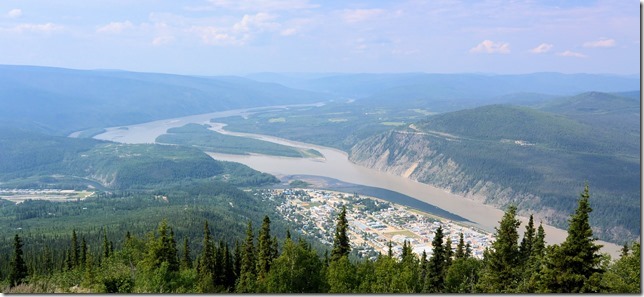
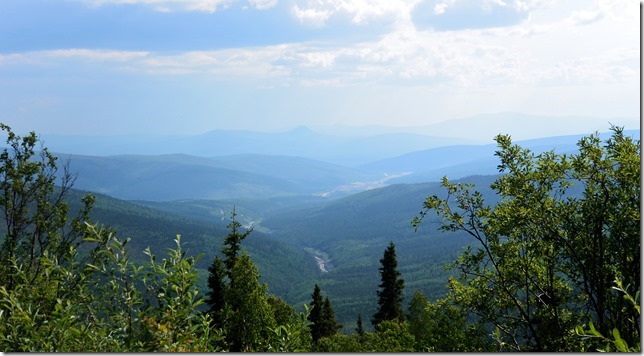
In 1896, forty-seven years had passed since the world-famous California gold rush. But two generations had done nothing to quench the ardor of fortune hunters. In fact, it could be said that the westward movement in the U.S. was primed and ready for another “bonanza”. Economic times were tough, and the lure of riches-beyond-imagining was irresistible.
Never mind that 99% of gold-seekers rarely broke even, let alone struck it rich. The optimism of miners appears to be at a competitive level with gamblers of all types – horses, cards, dice, stocks. “I’ll be the lucky one” is how the mentality works, pure and simple.
In real life, gold mining generally follows a common evolution: Surface gold is discovered, and the first lucky finders collect the “easy pickings”. Despite any and all attempts at secrecy, claims must be filed and gold must be brought to assay offices. Word leaks out, and within days or weeks at most, the rush is on.
Early arrivers dig through the next-most-difficult layers of dirt and rock, and many come away with sizeable amounts of gold. This, of course, brings the Rush to fever pitch. But by the time the masses arrive on-site, no easy gold remains. The gold to be found, after the first discovery, is scant and scarce, deeper in the ground and harder to separate from the obscuring soils. The labor to extract such gold dregs becomes greater and greater. Eventually, even the meanest labor rates still cannot be covered by the meager returns. The gold has “played out”, and the miners return to whence they came – or they migrate ever-hopefully off to a “new” discovery. From Sutter’s mill, to the Klondike, to Nome, the story repeats itself.
In Dawson, a new dimension was added to the classic tale. Dawson started as a typical gold-rush town, and might have followed its brothers into decline and oblivion but for a major economical/political event. Right around the turn of the century, the Canadian government saw that the gold fields could help to open up a harsh and difficult frontier. They granted massive gold-mining leases to a huge corporation, funded by deep-pocket financial groups. A colossal dredge-mining scheme was put into place, and literally millions of dollars were spent up-front to build roads, ponds, and major infrastructure to support the activity. For the next 50-odd years, Dawson continued to be a gold town. The dredges were massive affairs, and they continuously worked the gravel of the gold-bearing valleys, including seven miles of the Klondike River valley just west of town. The amount of rocks and gravel dredged up, filtered for gold, and re-deposited behind the dredges, has been estimated at 65,000,000 cubic yards. Think of a piece of land the size of San Jose, California, 500 feet deep, dug up, washed and rinsed, filtered and spit back out. It’s almost unimaginable. The tailing piles exist to this day, and will forever mark and describe the terrain. The piles are mostly gravel, not too much dirt, and new vegetation is slow to take hold. It takes nearly fifteen minutes to drive past all the tailings, at highway speeds.
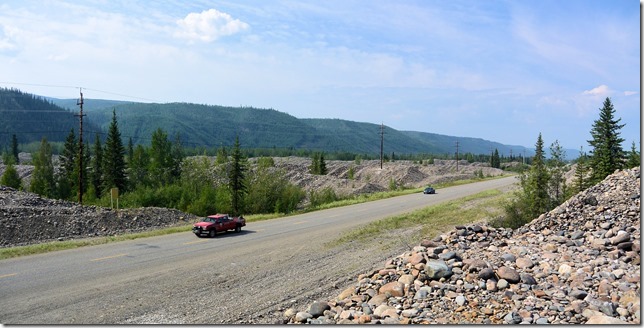
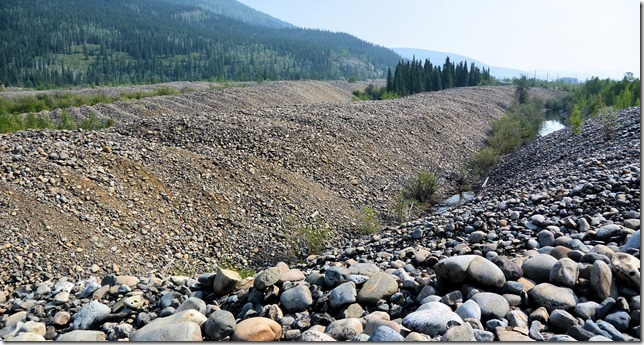
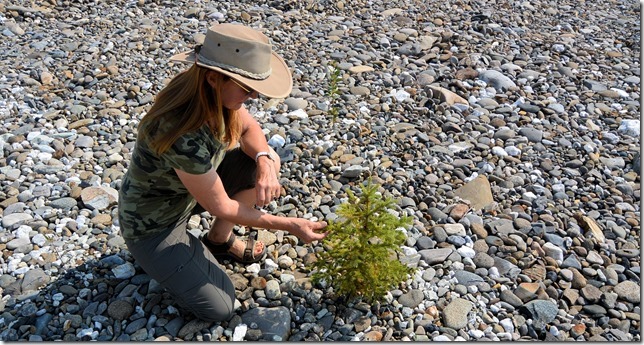
From a tourism perspective, despite the gravel-introduction, Dawson is pretty much a must-see. The township has done a wonderful job of preserving the early-1900’s feel of the place, with both old and new construction observing the earlier styles. Buildings ancient and modern are done up in crisp trim, flanking the dirt streets with a brightness seldom found up here in the northern regions of Canada. Cabin-style buildings are in a rich log-wood design that just shouts out “prospector”. It’s really easy to feel like you are strolling the avenues of a 1900 gold rush town – and in fact, you are.
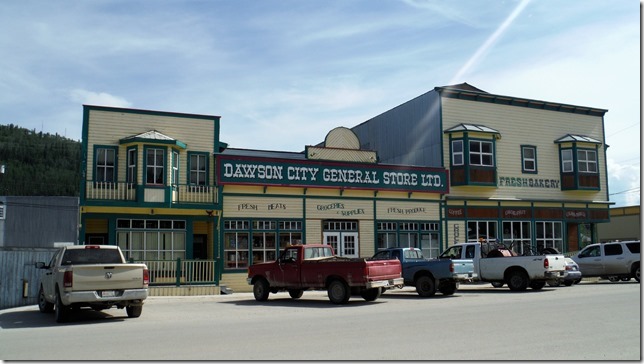
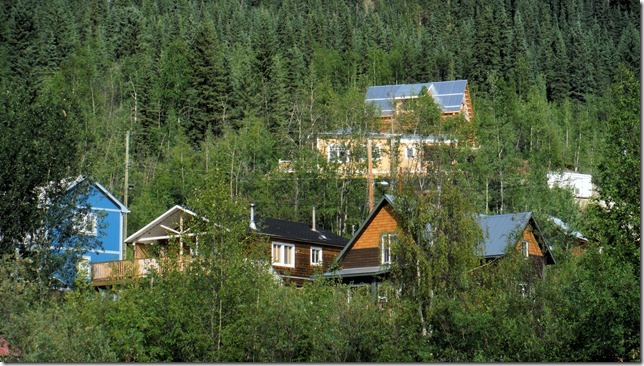
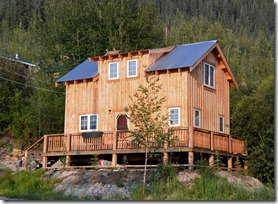
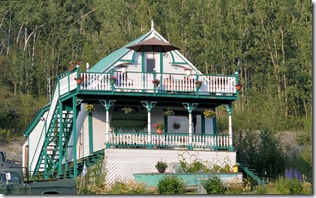
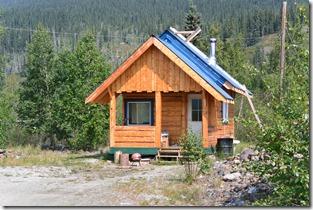
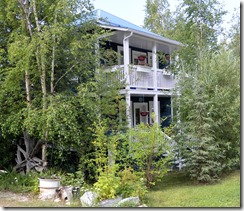
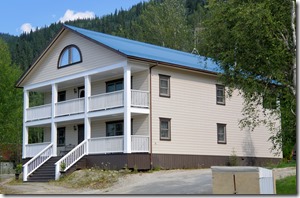
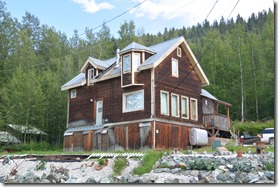
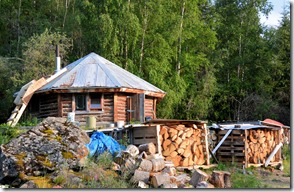
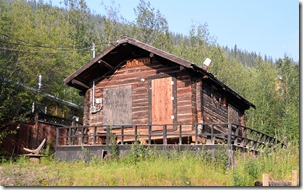
Dredge #4: Learning about gold dredging is an integral part of learning about Dawson. A major chunk of the town’s history is embodied in the preserved hulk of Dredge #4. And an hour-long tour really illuminates how the town was “saved” by the huge government-lease mining operation. Being inside the dredge, and imagining the life of the dredge-mining staff, is a real eye-opener.
Here’s the business-end of one of the largest dredges. The scoop-buckets make a giant chain (not shown) that goes around the big roller on the end.
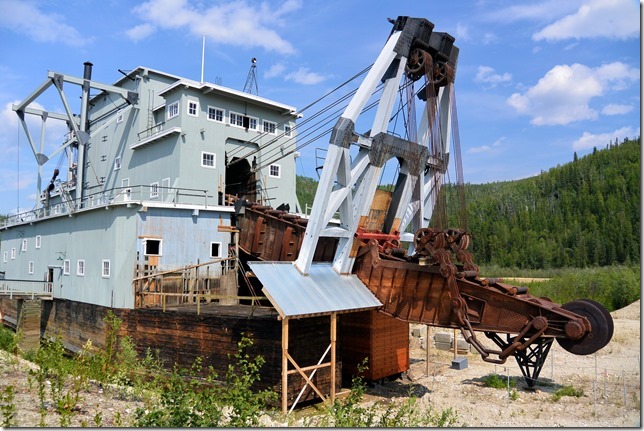
This is a drawing of how the whole process works. Scoop it up from the front, wash it through the trommel, convey the processed gravel up the tailing stalker and dump it behind the dredge.
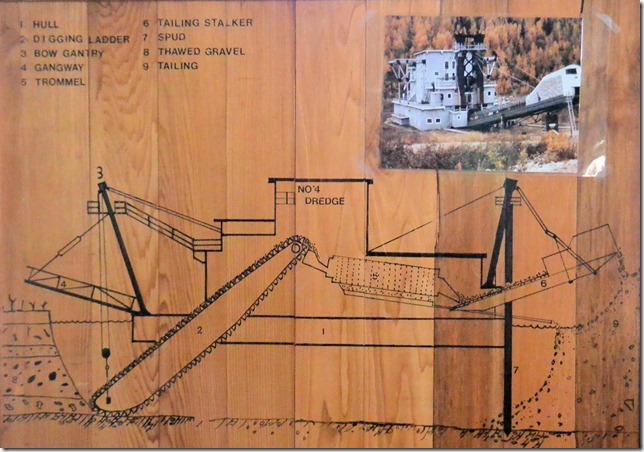
The thing I’m sitting on is one of dozens of buckets chained together, conveyor-belt like around the digging ladder. The pins that held them together are lying at my feet, solid steel all the way through. Any kind of lubricant would adversely affect the settling process of the gold – so all digging materials in contact with the water and gravel were non-lubricated. The NOISE made by a single dredge was so loud that it would disturb conversation in Dawson, eight miles away from the dredging site.
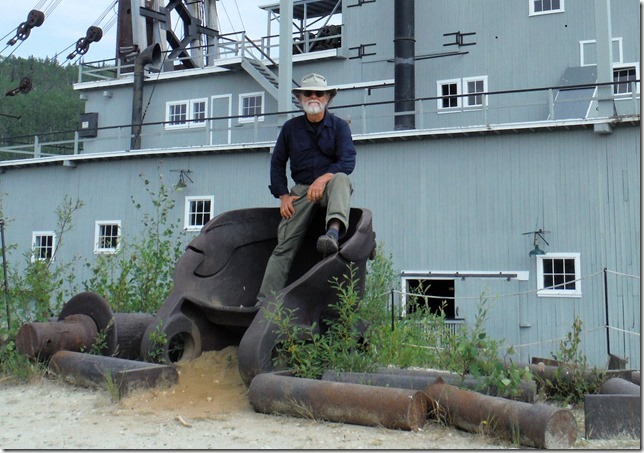
Steam, and later diesel engines drove generators to supply electric power to drive motors, clutches, and winches. Much of the “working” mechanism of the dredge was bought and shipped (including by paddle-wheeler, down the Yukon) from the Netherlands.
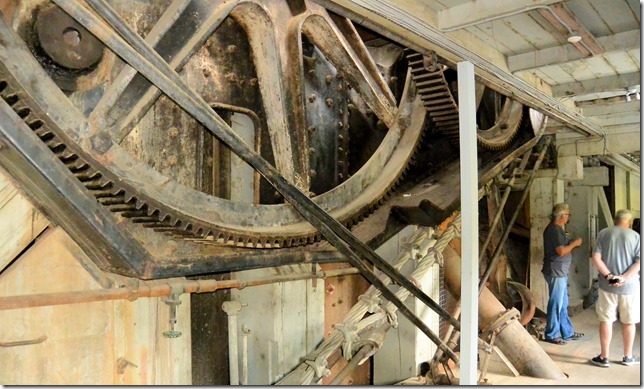
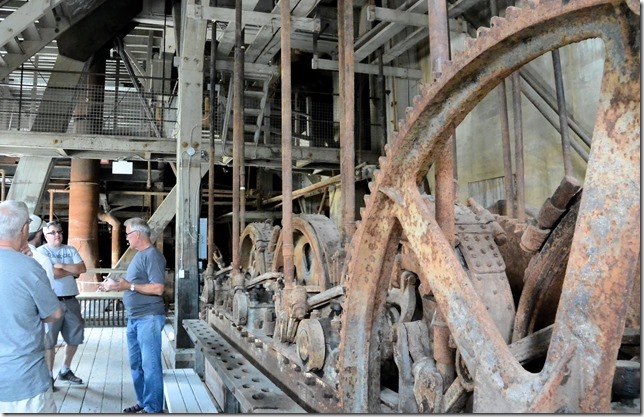
Each dredge had to be floated in a man-made pool, and supplied with more water than was naturally available. In winter, a dredge had to be blocked up and the pool drained, or freeze-up would crush the hull. And even with all the noise, horsepower and water-power, it’s been estimated that the big dredges were only about 60% efficient – that is, 40% of the available gold in the material processed was discarded. And it remains in those gravel beds to this day, which is why gold mining is still a hobby, and a business, in the Dawson gold fields.
Bonanza-Hunker Loop: This is about 60 miles of access road that goes way back into the gold country, away from the Klondike River valley and up into the more minor drainages. There’s active mining there today, and it was a not particularly scenic, but nonetheless interesting, drive. One of the things quickly obvious is that there are probably ten times more ideas how to mine for gold than there are people doing the mining. The variations in equipment and technique are literally endless. On one stretch, there’s a stream-bed dry-dredging operation, and a few miles later they’re doing the same on a ridge-line above the road.
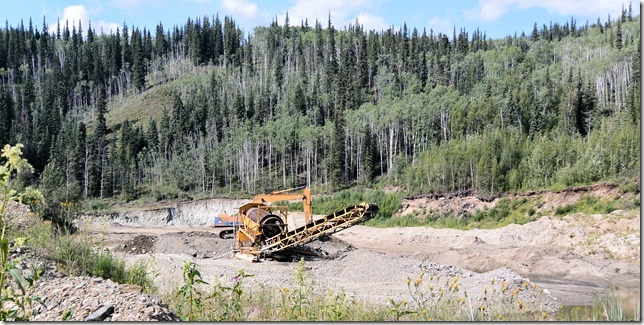
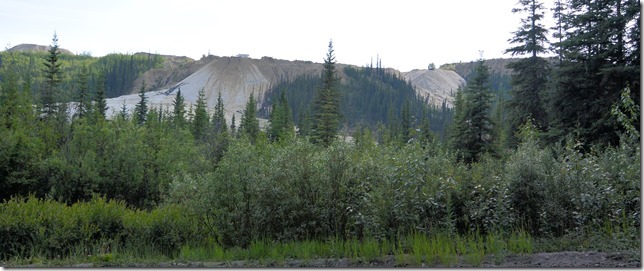
Today, unlike the first half of the 20th century, there are far stricter stipulations concerning environmental impact. That said, my overall impression was that these operations would curl the hair of any EPA employee (the U.S. Environmental Protection Agency, renowned for its rules and regulations).
Klondike Spirit: We were amazed to learn that steam-driven paddle-wheelers plied the Yukon as recently as the 1950’s and 1960’s. Dawson still has its own side-wheeler, and although it’s diesel powered, it still is propelled by the giant paddle wheels. We were pleased to get a two-hour ride up and down the Yukon (CA$100 including dinner). The Klondike Spirit tour has a pretty decent speech, presented over the PA system, but I also had the luck to talk with one of the deck hands for a half-hour or so, getting some extra info and insight into the riverboat operations. We also got to see some things that just aren’t accessible any other way.
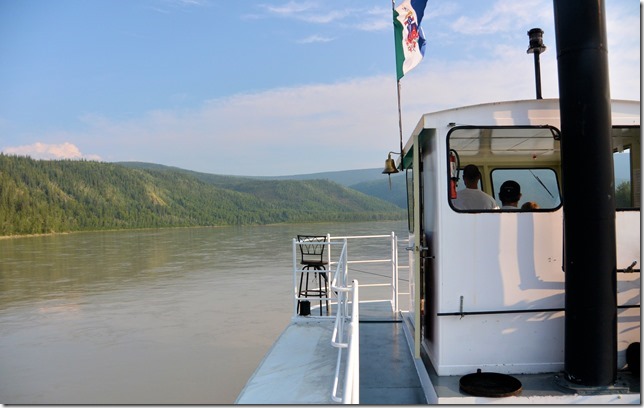
Such as the rotting wreck of a former paddle-wheeler along the western shore.
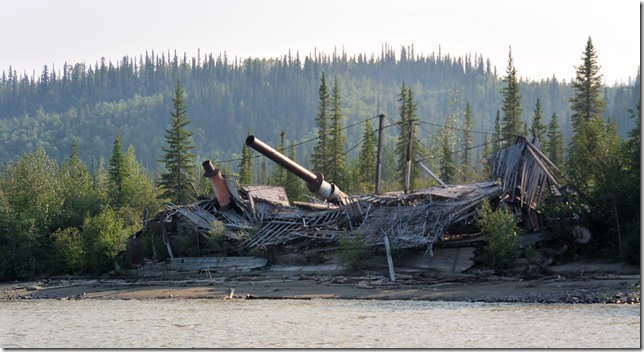
And the confluence of the Klondike (dark) with the Yukon (silty). The Yukon is silted heavily by the White River, which drains an area dense with volcanic ash. The rivers mix only slowly, so it’s possible to watch the colors blend over quite a distance.
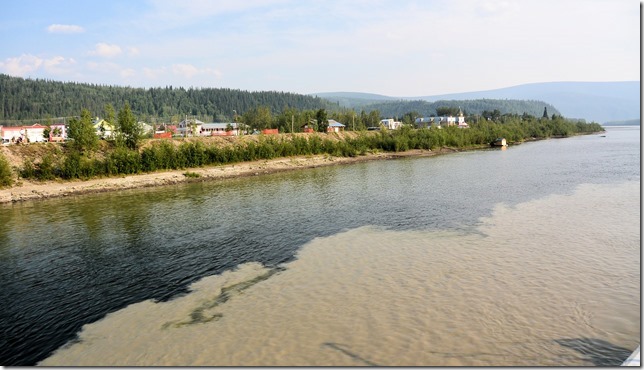
When the gold-seekers came in (by the thousands), the Natives, wisely, moved out. Under the guidance of a savvy chief, the people moved down-river to a new settlement, Moose-hide, reasonably isolated from the rowdy mining town. It’s possible to hike to and visit Moose-hide (with permission), but we elected to check it out from the water, during the cruise.
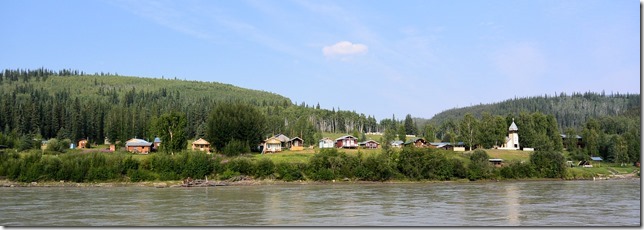
Near town, a private fishing-house is anchored to the river-bottom. The river is a kind of no-man’s-land, and the locals like the relative freedom from some of the town rules (public drinking, for example). My understanding is imperfect, but I believe it goes something like this: If you walk around drinking a beer in town or in the park, a Mountie can give you a ticket. But if you’re out at the fishing hut, you’re good to go.
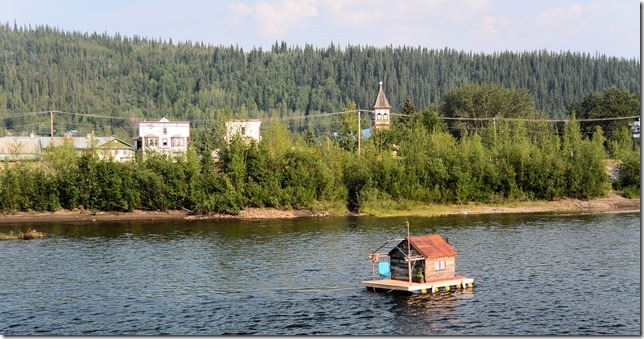
Coming back to town during the tour, a big blast on the boat whistle (ouch!) lets the ferry operator know that the Big Boy is coming. No sense arguing over whose river it is – – – the ferry stays on-shore while the side-wheeler navigates on by.
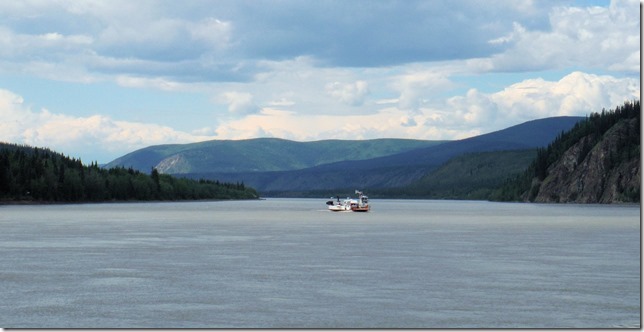
West Dawson and Freeze-up Break-up: The small subdivision to the west is separated from town by the Yukon River. Transportation is by ferry in the summer, and ice-bridge in the winter. That leaves Fall freeze-up and Spring break-up to contend with. When the river is either freezing or thawing, it cannot be negotiated by any vehicle or boat. Thin ice (freeze-up) or huge broken blocks of ice (break-up) make the river simply un-navigable. You cannot drive over to the Top-of-the-World highway at either time, and residents in West Dawson had better have prepared properly. It’s about a month, twice a year, of total isolation. These folks seem a bit more secluded and private, with cabins tucked away in the woods, tiny narrow dirt access roads, and an aura of Mountain Man pervading the trees. As with so many northern locales, we just can’t imagine how they live with six feet of snow and 20-below, no water, plumbing, or electricity. Rugged folks.
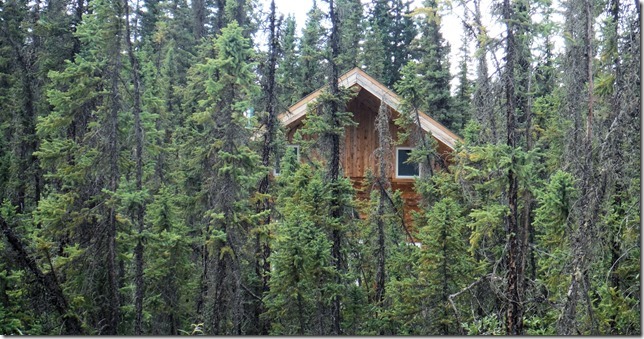
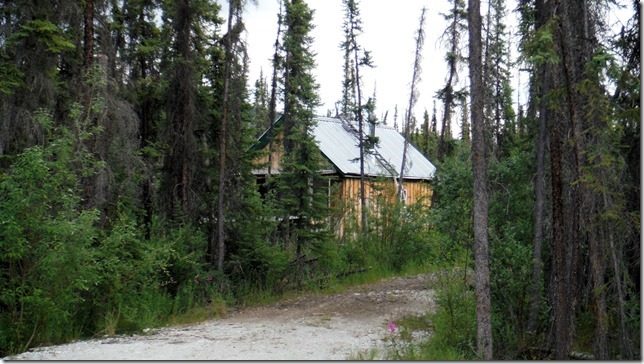
Top-of-the-World Highway: Dawson is the eastern terminus of this most-northern route to Alaska. The border crossing is the most northern crossing in the U.S. From the western bank of the Yukon, this highway winds across high terrain, and 105 miles from Dawson it enters the town of Chicken. But that’s a different story — and it’s coming up soon.
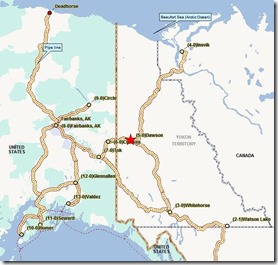
- Miles driven (Howie): 4,701
- Miles driven (Ralph): 1,165
- Days traveling: 51
- Miles from home: 2,728

Last time we were in Dawson (13 years ago) we took a riverboat down the Yukon river from Dawson to Eagle, AK. It was there that we were greeted by U.S. Customs and Immigration for our entry back into the U.S. Can’t wait to hear your impression of Chicken!
Greg,
Did you run into Tony Beets or Parker Schnavel (sp?) of “Gold Rush” on the Discovery Channel? Tony actually moved an old dredge last season, and intends to use it this season.
Did not know that….. interesting.
We were exploring outside Haines, Alaska while on a cruise some years ago, and turned around on a very narrow dirt road just a little too soon. The very first season of “Gold Rush” was being filmed just a couple of miles further up the road. Who knew?? The dredge Tony Beets moved last season outside Dawson hasn’t been run for 75 years.